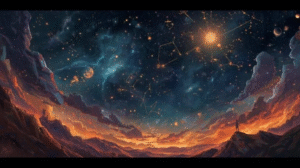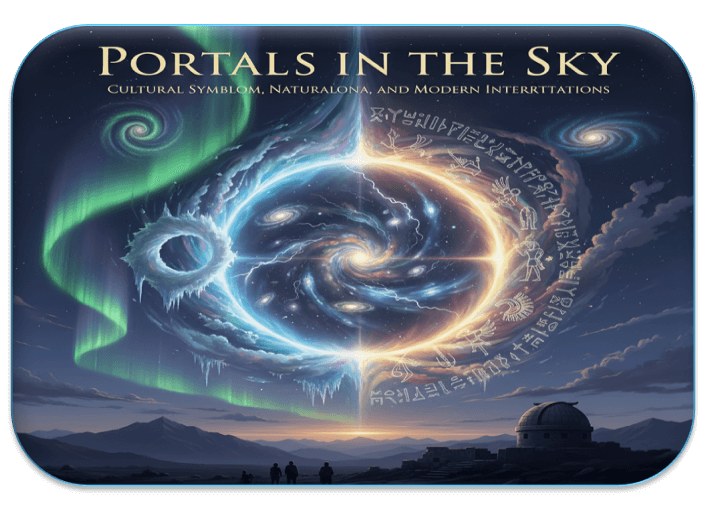
Portals in the Sky:
Cultural Symbolism, Natural Phenomena, and Modern Interpretations
Information:
Consequently, the sky holds a paramount position in the human worldview, representing a nexus of both immense might and profound, irreducible mystery. For societies across the globe, it has served a dual purpose: a reliable tool for practical navigation and a metaphorical gateway to elevated realities. A recurring motif across global mythologies, spiritual traditions, and contemporary discourse is the notion of “sky portals” or “celestial gates.” These are imagined as openings in the heavens, linking the terrestrial world with higher realities.
This article will examine the concept of sky portals through three key dimensions:
- Naturally occurring atmospheric phenomena
- Religious and cultural symbolism
- Scientific and speculative perspectives in modern thought
1.Naturally occurring atmospheric phenomena: ‘Portals’
1.1 Atmospheric Gateways
Some of the most striking natural spectacles can resemble gateways or openings in the sky.
- The result is an almost perfect “hole” in the sky, often surrounded by glowing sunlight, which visually resembles a gateway.
- Auroras (Northern and Southern Lights): These natural light displays, caused by charged particles from the solar wind colliding with Earth’s magnetic field, form luminous curtains and arcs in the upper atmosphere. To ancient peoples, these shifting, coloured lights appeared as moving gates or heavenly veils.
- Sprites, Blue Jets, and Elves: These rare, high-altitude lightning phenomena appear above thunderstorms, flashing in unusual forms and colours. Modern science identifies them as transient electrical discharges; their sudden luminosity lends them the visual quality of briefly activated celestial apertures.
1.2 Celestial Alignments
The movement of the sun, moon, and stars has often been described in terms of “openings” or “windows” in the heavens. Ancient cultures frequently aligned temples and monuments with solstices and equinoxes, treating the point at which the sun entered a new position as a form of cosmic gate.
2. Religious and cultural symbolism of Sky Portals:
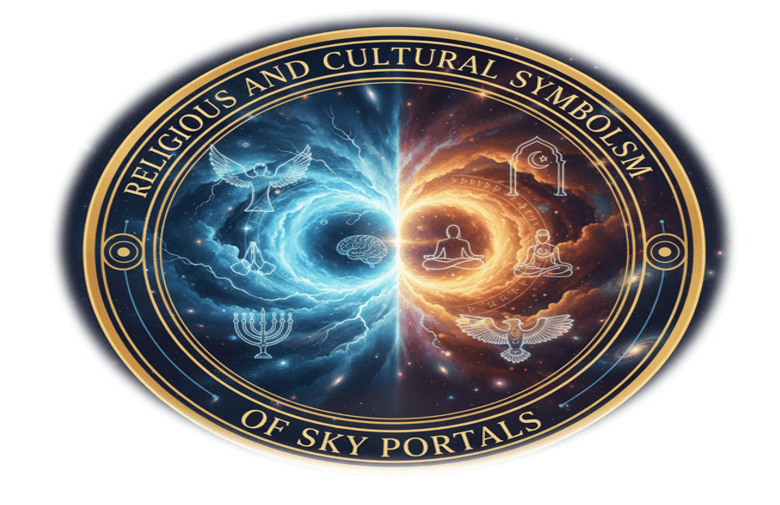
2.1 Ancient Civilisations
- Mesopotamian Beliefs: The Babylonians and Sumerians described the heavens as layered realms, with gates guarded by deities. These gates served as entry points to divine worlds.
- Egyptian Mythology: In the Book of the Dead, the soul of the deceased was believed to pass through gates in the sky to reach the afterlife. The pyramids themselves were often aligned with stars like as Orion, reflecting the idea of stellar gateways.
- Greek and Roman Traditions: Mount Olympus was often described as a threshold between the earth and the heavens, guarded by clouds and divine doors.
2.2 Abrahamic Traditions
Across Judaism, Christianity, and Islam, religious texts consistently describe the heavens as featuring “gates” or “doors.”
- The Hebrew Bible explicitly mentions the “windows of heaven” (Genesis 7:11) in its discussion of rainfall.
- Christianity refers to the “pearly gates” of Heaven, representing the boundary between earthly life and eternal reward.
- The concept of celestial access appears across Islamic texts. In the Qur’an (7:40) refers to the “gates of heaven” remaining shut to disbelievers. Accept Quran, Hadith collections frequently recount the opening and closing of heavenly portals for various divine purposes.
2.3 Indigenous and Shamanic Traditions
Many indigenous cultures describe sky portals as spiritual openings. For instance:
- Native American traditions actively regarded certain mountains and celestial events as doorways to higher worlds.
- In Andean cosmology, the Pachamama (Mother Earth) connects with the sky through sacred sites; communities believe these sites function as gateways to divine energy.
3. Scientific and speculative perspectives in modern thought:
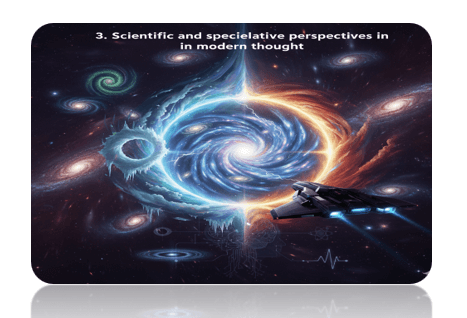
3.1 The Wormhole Hypothesis
In contemporary astrophysics, scientists often liken the wormhole—an Einstein-Rosen bridge—to a cosmic portal. Theoretically, these structures describe tunnels through spacetime that could potentially link distant parts of the universe. Popular science often frames these as “gateways in the cosmos,” echoing the imagery of ancient sky portals.
3.2 UFOs, Space Travel, and Conspiracy Theories
In the modern imagination, “sky portals” sometimes appear in accounts of UFO sightings or alleged government projects. Some theories suggest that advanced technologies might open dimensional gateways. There is no scientific evidence for these claims, their popularity in media and folklore shows how deeply the portal archetype resonates.
3.3 Symbolism in Literature and Popular Culture
Science fiction frequently reimagines the idea of sky portals as gateways for time travel, alien contact, or spiritual ascension. From films like Stargate to modern fantasy novels, the theme continues to thrive, blending myth with scientific speculation.
4. Interpretive Significance:
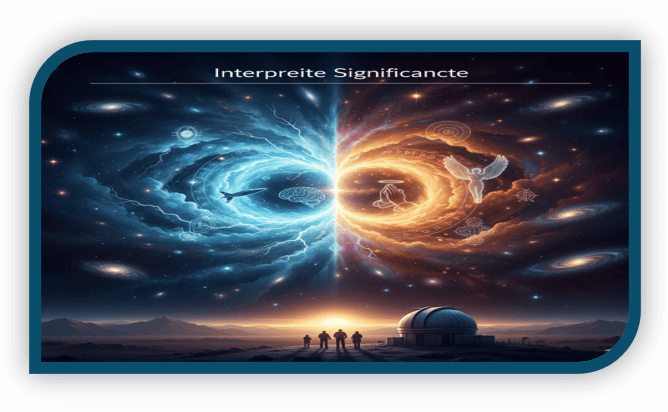
Why does the idea of sky portals important for us? One answer is that they represent humanity’s desire for transcendence — the wish to cross from the known into the unknown. the potent image of a glowing gateway in the sky—found across natural events, religious texts, and scientific speculation—forcefully suggests that human inquiry has always sensed a dimension lying beyond the scope of visible perception.
Conclusion:
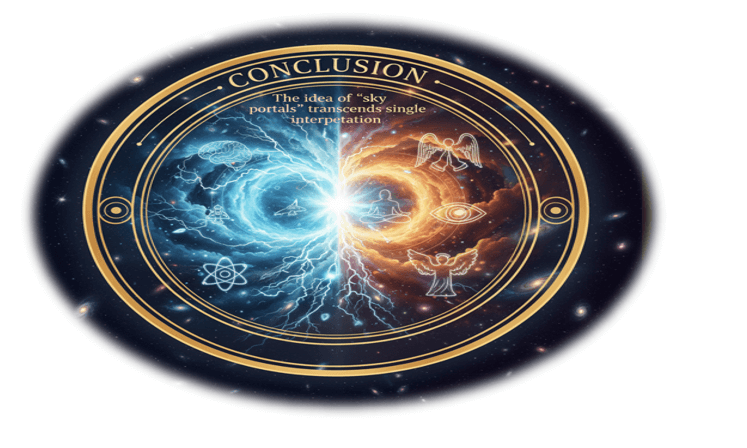
The idea of “sky portals” transcends single interpretation. At its most basic level, the term describes natural phenomena like auroras or fall streak clouds, which are essentially visual analogues for sky portals. Beyond this physical manifestation, it operates as a profound spiritual metaphor, signifying access to the divine or other higher dimensions. Crucially, speculative models in modern scientific discourse now mirror the concept; here, wormholes and advanced cosmic theories propose real gateways across the universe.
Far from being a single phenomenon, sky portals are a multifaceted symbol of human curiosity and imagination. Ultimately, the idea of sky portals stands at the critical intersection of science, spirituality, and imagination. The imagery synthesises these ideas, demonstrating that the heavens are far from a void. Instead, they represent a perpetual locus of human meaning, awe, and aspiration.



